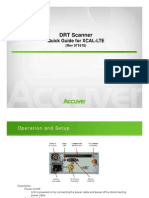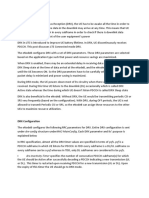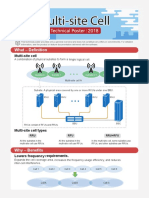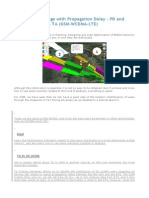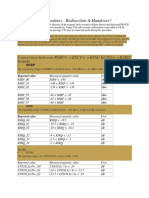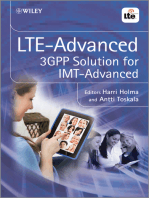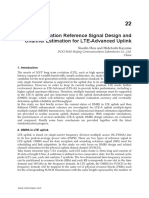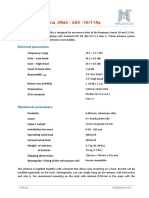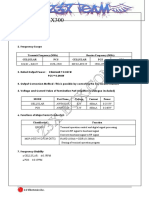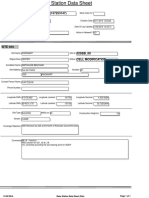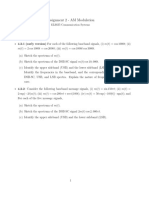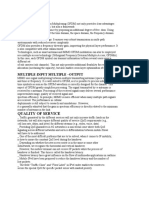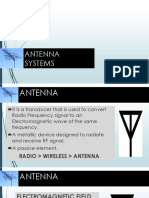DMRS Design and Channel Estimation For Lte Advanced UL
DMRS Design and Channel Estimation For Lte Advanced UL
Uploaded by
Stefano Della PennaCopyright:
Available Formats
DMRS Design and Channel Estimation For Lte Advanced UL
DMRS Design and Channel Estimation For Lte Advanced UL
Uploaded by
Stefano Della PennaOriginal Description:
Original Title
Copyright
Available Formats
Share this document
Did you find this document useful?
Is this content inappropriate?
Copyright:
Available Formats
DMRS Design and Channel Estimation For Lte Advanced UL
DMRS Design and Channel Estimation For Lte Advanced UL
Uploaded by
Stefano Della PennaCopyright:
Available Formats
Xiaolin Hou and Hidetoshi Kayama
DOCOMO Beijing Communications Laboratories Co., Ltd.
China
1. Introduction
The merits of 3GPP long term evolution (LTE), such as high spectral efciency, very low
latency, support of variable bandwidth, simple architecture, etc, make it the most competitive
candidate for the next generation mobile communications standard. In the rst release of LTE,
only single transmit antenna is supported in the uplink due to its simplicity and acceptable
performance. However, in order to keep its current leading position, LTE needs further
evolvement (known as LTE-Advanced (LTE-A)) to provide better performance, including a
higher uplink spectrum efciency. Therefore, multiple transmit antennas must be supported
in the LTE-A uplink and one important issue is the uplink demodulation reference signal
(DMRS) design, which will inuence uplink channel estimation accuracy and eventually
determine uplink reliability and throughput.
In this study we rst briey review the current status of DMRS in LTE uplink and then
different DMRS enhancement schemes are investigated for LTE-A uplink multiple-input
multiple-output (MIMO) transmission. Also, two-dimensional channel estimation algorithms
are provided to realize accurate uplink channel estimation. With computer simulations,
the performances of several candidate LTE-A uplink DMRS design schemes are evaluated
and compared. Finally some basic conclusions are provided together with the latest
standardization progress.
2. DMRS in LTE uplink
LTE uplink is based on single-carrier frequency division multiple access (SC-FDMA) due
to its low peak-to-average power ratio (PAPR). There are two types of reference signal in
LTE uplink: DMRS used for data reception and sounding reference signal (SRS) used for
scheduling and link adaptation. In this study we only focus on DMRS design and related
channel estimation for the physical uplink shared channel (PUSCH).
Take frame structure type 1 for example, each LTE radio frame is 10ms long and consists of
20 slots of length 0.5ms. A subframe is dened as two consecutive slots. For the normal cyclic
prex (CP) case, each slot contains 7 symbols. The two-dimensional time-frequency resource
can be partitioned as resource blocks (RBs) and each RB corresponds to one slot in the time
domain and 180 kHz in the frequency domain. In LTE uplink, the DMRS for PUSCH in the
frequency domain will be mapped to the same set of physical resource blocks (PRBs) used
for the corresponding PUSCH transmission with the same length expressed by the number of
Demodulation Reference Signal Design and
Channel Estimation for LTE-Advanced Uplink
22
subcarriers, while in the time domain DMRS will occupy the 4th SC-FDMA symbol in each
slot for the normal CP case, as shown in Fig. 1.
Fig. 1. DMRS in LTE uplink
In order to support a large number of user equipments (UEs) in multiple cells, a large number
of different DMRS sequences are needed. A DMRS sequence r
()
u,v
(n) is dened by a cyclic shift
(CS) of a base sequence r
u,v
(n) according to
r
()
u,v
(n) = e
jn
r
u,v
(n), 0 n < M
RS
sc
(1)
where M
RS
sc
= mN
RB
sc
is the length of DMRS sequence, m is the RB number and N
RB
sc
is the
subcarrier number within each RB. When the subcarrier bandwidth is set as 15kHz, each RB
will contain 12 subcarriers, i.e., N
RB
sc
= 12. Multiple DMRS sequences can be derived from a
single base sequence through different values of .
The denition of the base sequence depends on the sequence length. For M
RS
sc
3N
RB
sc
, the
base sequence is dened as the cyclic extension of the Zadoff-Chu sequence (Chu, 1972)
r
u,v
(n) = x
q
(nmodN
RS
ZC
), 0 n < M
RS
sc
(2)
x
q
(m) = e
j
qm(m+1)
N
RS
ZC
, 0 m < N
RS
ZC
1 (3)
where x
q
(m) is the q
th
root Zadoff-Chu sequence and N
RS
ZC
is the length of Zadoff-Chu
sequence that is given by the largest prime number such that N
RS
ZC
< M
RS
sc
. For M
RS
sc
<
3N
RB
sc
, the base sequence is dened as the computer generated constant amplitude zero
autocorrelation (CG-CAZAC) sequence
r
u,v
(n) = e
j (n)/4
, 0 n < M
RS
sc
(4)
where the values of (n) are given in (3GPP, TS 36.211).
Base sequences r
u,v
(n) are divided into 30 groups with u {0, 1, ..., 29}. Each group contains
one base sequence (v = 0) with 1 m 5 and two base sequences (v = 0, 1) with 6
m N
max,UL
RB
, where N
max,UL
RB
is the maximum RB number in the uplink. In order to reduce
inter-cell interference (ICI), neighboring cells should select DMRS sequences from different
base sequence groups. Furthermore, there are 3 kinds of hopping dened for the DMRS in LTE
uplink, i.e., group hopping, sequence hopping and CS hopping, where CS hopping should
always be enabled in each slot.
The CS value in a slot is given by = 2n
cs
/12 with
n
cs
= (n
(1)
DMRS
+ n
(2)
DMRS
+ n
PRS
)/12 (5)
where n
(1)
DMRS
is a broadcast value, n
(2)
DMRS
is included in the uplink scheduling assignment
and n
PRS
is given by a cell-specic pseudo-random sequence. Obviously, there are 12 usable
CS values in total for DMRS in LTE uplink.
418 Advances in Vehicular Networking Technologies
3. DMRS design and channel estimation for LTE-A uplink
3.1 DMRS enhancement
Current LTE uplink DMRS only considers UE with single transmit antenna. However, in order
to boost the uplink spectrum efciency, multiple transmit antennas must be supported in
LTE-A uplink. Therefore, the uplink DMRS must be enhanced for MIMO transmission and
each UE nowmay have multiple DMRS sequences, depending on its transmit antenna number
(without precoding) or spatial layer number (with precoding).
There are several possible solutions, including CS extension, orthogonal cover code (OCC),
interleaved frequency division multiplexing (IFDM) and their combinations. Considering the
backwards compatibility with LTE and the low PAPR requirement for uplink transmission,
IFDM should be excluded rst. Then CS, OCC and their combinations are promising
candidates for DMRS enhancement and will be discussed in more details in the following
text.
3.1.1 Baseline: CS extension
Considering the backwards compatibility, it is agreedthat cyclic shift separation is the baseline
for the LTE-A uplink DMRS enhancement (3GPP, TR 36.814). Without loss of generality,
uplink precoding is not considered in the following text, therefore, transmit antenna
and spatial layer are equivalent and interchangeable. For single-user MIMO (SU-MIMO)
transmission with n
T
2 spatial layers, it is natural to assign multiple CS values to separate
the multiple spatial layers. Then the questions remained to be answered are how to assign
different CS values to different spatial layers and how to ensure the backwards compatibility
to LTE.
If we assign multiple CS values with the following constraint
n
cs,i
= (n
cs,0
+
C
n
T
i)mod(C), i = 0, 1, ..., n
T
1 (6)
where n
cs,i
corresponds to the CS value of DMRS for the ith spatial layer and C is the constant
value 12 for PUSCH. Then the CS value of DMRS for the rst spatial layer
0
= 2n
cs,0
/12 is
exactly the same as that for the single transmit antenna case in LTE. Therefore, all the original
CS signaling and hopping designs for the single transmit antenna UE in LTE can be kept
unchanged for the multiple transmit antennas UE in LTE-A, once the constraint in Eq. (6) is
satised.
Because this DMRS design can be viewed as binding together the CS values of DMRS as well
as the channel impulse response (CIR) positions of different spatial layers with the maximum
distance constraint, as illustrated in Fig. 2 (Note that the relationship between
i
and
0
will
keep unchanged during CS hopping), we simply call it maximum distance binding (MDB).Its
benets include:
First, the distance between CIRs of different spatial layers in the time domain can be
always maximized, thus the interference between DMRS of different spatial layers can be
minimized;
Second, no additional signaling is required for CS notication and hopping when support
uplink MIMO transmission, therefore, it is completely backwards compatible to LTE;
Third, it can support time-domain inter-slot interpolation that is necessary for moderate to
high mobility cases.
419 Demodulation Reference Signal Design and Channel Estimation for LTE-Advanced Uplink
Fig. 2. CS extension with MDB
Actually, the same DMRS design principle can also be applied to the uplink multi-user MIMO
(MU-MIMO) transmission with single transmit antenna UEs. Now it only requires some
constraint in the uplink scheduling assignment for the CS values of multiple DMRS (because
n
(1)
DMRS
and n
PRS
are the same for all the UEs in the same cell, respectively) as follows
n
(2)
DMRS,i
= (n
(2)
DMRS,0
+
C
n
T
i)mod(C), i = 0, 1, ..., n
T
1 (7)
where n
(2)
DMRS,0
is the scheduled value for the rst UE.
In order to support the above CS scheduling constraint for MU-MIMO transmission, we have
two possible options:
Option 1: No signaling modication
Because the current LTE specication only supports 8 possible values for n
(2)
DMRS
(3GPP,
TS 36.211), a limited number of combinations can be chosen in the uplink scheduling
with the MDB constraint (7) satised. Therefore, for the 2-user case, n
(2)
DMRS,i
{(0, 6), (2, 8), (3, 9), (4, 10)}; while for the 4-user case, n
(2)
DMRS,i
{(0, 3, 6, 9)}.
Option 2: Slight signaling modication
If the specic eld in downlink control information (DCI) format 0 for the CS of DMRS can
be increased from 3 bits to 4 bits, all the possible combinations in the CS scheduling for
MU-MIMO transmission can be supported with the MDB constraint (7) satised.
3.1.2 Further enhancement: CS + OCC
For high-order SU-MIMO, MU-MIMO and coordinated multi-point (CoMP) reception that
will be supported in the further evolvement of LTE, the number of superposed spatial layers
will increase to four or even eight. In order to reduce the interference between multiple spatial
layers, OCC, such as [+1, +1] and [+1, 1], can be further introduced across the two DMRS
symbols within the same subframe.
For MU-MIMO and CoMP reception, CS + OCC can provide some special advantage
compared to CS only scheme, such as capability to multiplex UEs with different transmit
bandwidths and robustness to timing difference of multiple UEs. For SU-MIMO, CS + OCC
420 Advances in Vehicular Networking Technologies
may also be attractive for high-order MIMOtransmission and/or high-order modulation. The
combination of CS and OCC could have two variations, i.e., CS + OCC with identical CS and
CS + OCCwith offset CS (TI, 2009), as illustrated in Fig. 3 (a) and Fig. 3 (b), respectively, taking
four spatial layers for example.
(a) CS + OCC
(b) CS + OCC (offset)
Fig. 3. Combination of CS and OCC
However, OCC will lose its effectiveness in some cases, such as when the mobility
increases from low to moderate or PUSCH hopping happens within one subframe. In the
aforementioned situations, CS + OCC with identical CS, abbr. as CS + OCC, cannot work
at all; while CS + OCC with offset CS , abbr. as CS + OCC (offset), still can work, but in
essence only CS takes effect now. Obviously, CS + OCC (offset) occupies twice CS resources
compared to CS + OCC. Meanwhile, to introduce OCC into LTE-Auplink DMRS design, some
additional control signaling may be needed. Otherwise, the linkage between OCC and CS
must be dened to avoid increasing control signaling, i.e., the notication of OCC could be
realized in an explicit way.
3.2 Two-dimensional channel estimation
In order to obtain the time-frequency two-dimensional channel state information (CSI) in
the SC-FDMA uplink, two-dimensional channel estimation is needed for each subframe.
Without loss of generality, assume that the inter-symbol interference (ISI) and the inter-carrier
interference (ICI ) are small and neglectable. Therefore, for PDSCH and corresponding DMRS
421 Demodulation Reference Signal Design and Channel Estimation for LTE-Advanced Uplink
within one subframe, the received signal at the k-th subcarrier in the l-th SC-FDMA symbol
can be written as
Y(k, l) = H(k, l) X(k, l) + N(k, l), k
0
k < k
0
+12 N
UL
RB
1, 0 l < 14 (8)
where X(k, l), H(k, l) and N(k, l) denote the transmitted signal, the channel frequency
response (CFR) and the additive white Gaussian noise (AWGN) with zero mean and variance
2
for the k-th subcarrier in the l-th SC-FDMAsymbol, respectively. k
0
is the frequency starting
position of PUSCH and N
UL
RB
is the uplink RB number for PUSCH. For the multipath wireless
channel within one SC-FDMA symbol, the CFR can be related to the CIR as
H(k, l) =
G1
g=0
h(g, l) e
j2kg/K
(9)
where h(g, l) is the g-th multipath component and G is the sample number corresponding to
the maximum multipath delay.
The rst step of two-dimensional channel estimation is to obtain the initial estimated
superposed channels within the two DMRS symbols, i.e.,
H(k, 3) and
H(k, 10), as follows
H(k, l) = Y(k, l) conj(r
(
0
)
u,v
(k)), l = 3, 10 (10)
where conj() represents the complex conjugate and without loss of generality, PUSCH and
DMRS hopping are not considered.
To facilitate the following description, dene the nal estimated channel as
H(k, l). Then the
target of two-dimensional channel estimation is to derive each data symbols
H(k, l) from
H(k, 3) and
H(k, 10). Taking the implementation complexity into account, two concatenated
one-dimensional channel estimation, i.e., frequency-dimensional channel estimation and
time-dimensional channel estimation, will be considered in this study.
3.2.1 Frequency-dimensional channel estimation
For frequency-dimensional channel estimation, discrete-time Fourier transform (DFT) based
channel estimation (Edfors et al., 2000) could be utilized. However, because the RB allocation
to a given UE is generally only a small portion of the overall uplink bandwidth, the CIR energy
leakage will be observed in practice, as shown in Fig. 4, where the rst and the second rows
are for two-antenna and four-antenna cases, while the left and the right columns are for RB#
= 1 and RB# = 10 cases, respectively. Its obvious that the smaller the RB number, the more
severe the CIR energy leakage. This phenomenon will make the CIRs from different transmit
antennas superposed together and difcult to be separated with each other, especially when
the transmit antenna number becomes larger. Furthermore, the frequency domain Gibbs
phenomenon (Oppenheimet al., 1999) will appear at the edges of assignedconsecutive RBs for
a given UE due to the signal discontinuities. Therefore, the estimation accuracy of traditional
DFT-based channel estimation will deteriorate signicantly in practice.
In order to mitigate the aforementioned problems, an improvedDFT-basedchannel estimation
was proposed for LTE(-A) uplink (Hou et al., 2009), which is illustrated in Fig. 5 for each
receive antenna of eNB. After serial-to-parallel (S/P) conversion and K-point fast Fourier
transform (FFT), the received signal is transformed into the frequency domain. Because each
UE (except for UEs in the same MU-MIMOtransmission) occupies different RBs in the uplink,
we can rst separate different UEs by way of frequency division multiplexing (FDM). Then
taking channel estimation for UE1 for example, multiply the separated received DMRS by
422 Advances in Vehicular Networking Technologies
Fig. 4. CIR energy leakage
the complex conjugate of the DMRS sequence assigned for the 1st spatial layer and perform
K-point inverse FFT (IFFT) to get the superposed CIRs in the time domain, i.e.,
h(g, l) = i f f t(
H(k, l)), 0 k < K, l = 3, 10 (11)
After the operation of dynamic CIR reservation (DCIR
2
), we can seperate the CIRs for different
spatial layers by way of different CS values. As for the operation of DCIR
2
, the dynamically
reserved CIR for each spatial layer consists of 2 parts with respect to the timing positions, i.e.,
(
C
n
T
i) K, i = 0, 1, ..., n
T
1:
Right part
There are CP samples preserved with the following right boundary
(
C
n
T
i) K + CP 1, i = 0, 1, ..., n
T
1 (12)
where CP is the cyclic prex length of the SC-FDMA symbol and is an adjustable
parameter (0 < 1) that can be optimized in practical implementations.
Left part
There are samples preserved with the following left boundary
423 Demodulation Reference Signal Design and Channel Estimation for LTE-Advanced Uplink
[(
C
n
T
i) K + K]mod(K), i = 0, 1, ..., n
T
1 (13)
where is the main lobe width of CIR energy leakage ( =
K
12RB#
) and is an adjustable
parameter (0 <
K/n
T
CP
) that can be optimized in practical implementations. In
order to simply the adjustment, we can dene
=
K
12
and =
RB#
, therefore,
becomes
a constant and only should be adjusted.
The proper choices of and are mainly determined by the noise level, the multipath delay
prole and the assigned RB number for a given UE. And afer DCIR
2
, we can obtain the CIR
for the i-th spatial layer as
h
i
(g, l).
Finally, the frequency-dimensional channel estimation result of DMRS symbols for the i-th
spatial layer can be achieved by K-point FFT and provided to the following time-dimentional
channel estimation block.
H
i
(k, l) = i f f t(
h
i
(g, l)), 0 g < K, l = 3, 10 (14)
Another point should be emphasized is the operation of frequency domain
windowing/dewindowing . Due to the frequency domain Gibbs phenomenon caused
by the discontinuities at the edges of assigned consecutive RBs for a given UE, the overall
channel estimation accuracy will be degraded, especially at the edges of assigned consecutive
RBs. Therefore, some frequency domain window, such as Hanning window, Hamming
window, Blackman window, etc. (Oppenheim et al., 1999), can be further added (see the
dashed-line blocks in Fig. 5) to improve the channel estimation accuracy with some additional
complexity. For example, Blackman window will be adopted in our following computer
simulations.
w(n) = 0.42 0.5cos(2n/M) +0.08cos(4n/M) (15)
where M is the window length and 0 n M. In order not to eliminate the useful signals
within the assigned RBs, the window length should be larger than the assigned bandwidth
(12 RB#) for the corresponding UE.
Note that the improved DFT-based channel estimation can be applied to not only LTE-A
MIMO uplink, but also LTE single-input single-output (SISO) or single-input multiple-output
(SIMO) uplink.
3.2.2 Time-dimensional channel estimation
After frequency-dimensional channel estimation, we only obtain channel estimation results
for two DMRS symbols within each subframe. In order to further acquire channel estimation
result for each data symbol, time-dimensional channel estimation is needed, i.e., inter-slot
interpolation via two DMRS symbols within each subframe. Two practical schemes are
time-dimensional linear interpolation (TD-LI) and time-dimensional average or despreading
(TD-Average/Despreading), i.e.,
H(k, l) = c
l
H(k, 3) + (1 c
l
)
H(k, 10), 0 l < 14 (16)
c
l
= (10 l)/7 , TD LI
c
l
= 1/2 , TD Average
(17)
424 Advances in Vehicular Networking Technologies
Fig. 5. The improved DFT-based channel estimation
It should be noted that for the case of CS + OCC with identical CS, TD-Despreading must be
carried out before frequency-dimensional channel estimation.
4. Performance evaluation
Computer simulation results, including both block error rate (BLER) and throughput
performances, will be provided in this section to compare different DMRS design schemes,
i.e., CS only, CS + OCC and CS + OCC (offset).
The simulation parameters are listed in Table 1. Notice that the FFT size is larger than
the usable subcarrier number because of the existence of guard band. There are totally
50 RBs in the uplink and we consider two RB# allocation cases with RB# = 4, 10,
respectively. Furthermore, 2 typical MIMO congurations, i.e., 2 2 and 4 4, are both
simulated. The MIMOtransmission scheme is spatial multiplexing without precoding and the
MIMO detection scheme is minimum mean square error (MMSE) detection. Without loss of
generality, synchronization error and PUSCH hopping are not considered. For the improved
DFT-based frequency-dimensional channel estimation, we simply chose = 0.5 and = 0.2
and the frequency domain window length is set to be M = 1.1 RB# 12. The channel model
is selected as typical urban (TU) with mobility of 3km/h or 30km/h.
First, BLER performances of different DMRS design schemes will be compared. The
same frequency-dimensional channel estimation is utilized for different DMRS design
schemes and time-dimensional channel estimation could be different, i.e., CS + OCC
can only use TD-Despreading, while CS only and CS + OCC (offset) can use TD-LI or
TD-Average/Despreading. Furthermore, the curve with perfect CSI is also provided in
each gure for comparison. The BLER performances are evaluated with two representative
congurations, i.e., 10RB with 16QAM and 4RB with 64QAM (the coding rate is 1/2), for
2 2 and 4 4 MIMO, respectively.
When the mobile speed is as lowas 3km/h, Fig. 6 shows that for the 2 2 MIMOcase different
DMRS design schemes have almost the same BLER performance. The only difference comes
from time-directional channel estimation, i.e., TD-Average/Despreading can achieve slightly
better performance than TD-LI due to the noise averaging effect in low mobility cases. And
fromFig. 7, it can be observed that for the 4 4 MIMOcase the introduction of OCC is helpful
to improve the BLER performance in low mobility cases, especially when the RB number is
small and/or the modulation order is high.
425 Demodulation Reference Signal Design and Channel Estimation for LTE-Advanced Uplink
Parameters Values
Carrier frequency 2GHz
Bandwidth 10MHz
FFT size 1024
Usable subcarrier # 600
Cyclic prex 72
Assigned RB # 4, 10
MIMO conguration 2 2
(Spatial multiplexing) 4 4
MIMO detection MMSE
Modulation QPSK,16QAM,64QAM
Channel coding
Turbo
(Coding rate 1/2, 2/3, 3/4)
Synchronization Perfect
PUSCH hopping Disabled
DMRS design
CS Only
CS + OCC
CS + OCC (offset)
Frequency-dimensional Improved DFT-based
channel estimation
Time-dimensional TD-LI
channel estimation TD-Average/TD-Despreading
Channel model Typical Urban (TU)
Mobile speed 3km/h, 30km/h
Table 1. Simulation parameters
However, if the mobile speed increases fromlowto moderate, i.e., from3km/h to 30km/h, the
aforementioned conclusion has to be revised. As shown in Fig. 8, now CS only with TD-LI can
achieve the best performance and OCC will lose its effectiveness. The reason behind is that
when the mobile speed is as high as 30km/h, the wireless channels between two consecutive
slots are relatively fast time-varying, which makes TD-Average/Despreading cannot work
well. On the other hand, TD-LI can still track the time-varying channel effectively. Therefore,
from the mobility point of view, OCC has its apparent limitation, i.e., OCC will mainly work
in the low mobility cases. However, considering the major application scenario of MIMO is
the low mobility environment, OCC is still attractive for DMRS enhancement. And in the
following simulations only 3km/h is considered.
In order to provide a more comprehensive comparison between different DMRS design
schemes, the throughput performances with different modulation level and coding rate are
provided in Fig. 9 and Fig. 10 for 2 2 and 4 4 MIMO, respectively. Three different
modulation schemes (QPSK, 16QAM, 64QAM) and three different coding rates (1/2, 2/3, 3/4)
are simulated, so in total there are nine combinations of modulation and coding. Considering
the mobile speed is low, TD-Average/Despreading will be adopted instead of TD-LI. Also
under this situation, because CS + OCC and CS + OCC (Offset) have neglectable performance
difference, only CS + OCC is simulated, together with CS only and perfect CSI. Therefore,
in each gure there are 27 curves, shown by different line styles and markers. For each
DMRS design scheme, only the envelop of nine curves (each with one specic combination
of modulation and coding) is highlighted to show the highest achievable throughput, which
426 Advances in Vehicular Networking Technologies
5 10 15 20 25
10
3
10
2
10
1
10
0
E
s
/N
0
(dB)
B
L
E
R
Perfect CSI
CS Only(TDAverage)
CS Only(TDLI)
CS+OCC
CS+OCC(ofset)(TDDespreading)
CS+OCC(ofset)(TDLI)
(a) 10RB, 16QAM
5 10 15 20 25
10
3
10
2
10
1
10
0
E
s
/N
0
(dB)
B
L
E
R
Perfect CSI
CS Only(TDAverage)
CS Only(TDLI)
CS+OCC
CS+OCC(ofset)(TDDespreading)
CS+OCC(ofset)(TDLI)
(b) 4RB, 64QAM
Fig. 6. BLER performance (2 2 MIMO, TU, 3km/h)
427 Demodulation Reference Signal Design and Channel Estimation for LTE-Advanced Uplink
5 10 15 20 25
10
3
10
2
10
1
10
0
E
s
/N
0
(dB)
B
L
E
R
Perfect CSI
CS Only(TDAverage)
CS Only(TDLI)
CS+OCC
CS+OCC(ofset)(TDDespreading)
CS+OCC(ofset)(TDLI)
(a) 10RB, 16QAM
15 20 25 30 35
10
3
10
2
10
1
10
0
E
s
/N
0
(dB)
B
L
E
R
Perfect CSI
CS Only(TDAverage)
CS Only(TDLI)
CS+OCC
CS+OCC(ofset)(TDDespreading)
CS+OCC(ofset)(TDLI)
(b) 4RB, 64QAM
Fig. 7. BLER performance (4 4 MIMO, TU, 3km/h)
428 Advances in Vehicular Networking Technologies
5 10 15 20 25
10
3
10
2
10
1
10
0
E
s
/N
0
(dB)
B
L
E
R
Perfect CSI
CS Only(TDAverage)
CS Only(TDLI)
CS+OCC
CS+OCC(ofset)(TDDespreading)
CS+OCC(ofset)(TDLI)
Fig. 8. BLER performance (4 4 MIMO, 10RB, 16QAM, TU, 30km/h)
429 Demodulation Reference Signal Design and Channel Estimation for LTE-Advanced Uplink
5 0 5 10 15 20 25 30
0
1
2
3
4
5
E
s
/N
0
(dB)
T
h
r
o
u
g
h
p
u
t
(
M
b
p
s
)
Perfect CSI
CS Only
CS+OCC
(a) 4RB
5 0 5 10 15 20 25 30
0
2
4
6
8
10
12
14
E
s
/N
0
(dB)
T
h
r
o
u
g
h
p
u
t
(
M
b
p
s
)
CS Only
CS+OCC
Perfect CSI
(b) 10RB
Fig. 9. Throughput performance (2 2 MIMO, TU, 3km/h)
430 Advances in Vehicular Networking Technologies
5 0 5 10 15 20 25 30
0
1
2
3
4
5
6
7
8
9
10
E
s
/N
0
(dB)
T
h
r
o
u
g
h
p
u
t
(
M
b
p
s
)
CS Only
Perfect CSI
CS+OCC
(a) 4RB
5 0 5 10 15 20 25 30
0
5
10
15
20
25
E
s
/N
0
(dB)
T
h
r
o
u
g
h
p
u
t
(
M
b
p
s
)
Perfect CSI
CS Only
CS+OCC
(b) 10RB
Fig. 10. Throughput performance (4 4 MIMO, TU, 3km/h)
431 Demodulation Reference Signal Design and Channel Estimation for LTE-Advanced Uplink
could be viewed as the throughput performance with the ideal adaptive modulation and
coding. From Fig. 9 and Fig. 10, we can observe that the introduction of OCC can improve
throughput to some extent when some of the following situations are satised, i.e., the antenna
number is large, the RB number is small, and the sigal-to-noise ratio is high.
5. Some basic conclusions and standardization progress
DMRS enhancement is a key step to support MIMO transmission, including SU-MIMO,
MU-MIMO and CoMP, for LTE-A uplink. In this study different DMRS design schemes as
well as channel estimation are investigated. In addition to the baseline of CS extension, the
further combination of CS with OCC is also discussed. In addition to the special advantage
for MU-MIMO and CoMP, CS + OCC is also attractive for high-order SU-MIMO to further
suppress the interferences among the increasing multiple spatial layers. With the enhanced
DMRS design and improved channel estimation, a higher spectrum efciency can be realized
in LTE-A uplink. Meanwhile, considering the backwards compatibility, as less as possible
modication to the current LTE specication is preferred.
In the recent 3GPP RAN1 meetings, it was agreed that (3GPP, R1-102601)
Introduce the OCC in Rel-10 without increasing uplink grant signaling overhead
OCC can be used for both SU-MIMO and MU-MIMO
More design details about DMRS enhancement, such as CS and OCC linkage, DMRS hopping,
etc., are still under discussions and hopefully the uplink DMRS enhancement for LTE-A will
be nalized by the end of 2010.
6. References
3GPP. R1-102601: Final report of 3GPP TSG RAN WG1 #60bis, 3GPP TSG RAN WG1 Meeting
#61, Montreal, Canada, May 10-14, 2010.
3GPP TR 36.814 http://www.3gpp.org/ftp/specs/html-info/36814.htm
3GPP TS 36.211 http://www.3gpp.org/ftp/specs/html-info/36211.htm
Chu, D. C. (1972). Polyphase codes with good periodic correlation properties. IEEE Trans. Info.
Theory, Vol. 18, No. 4, July 1972, pp. 531-532, ISSN 0018-9448
Edfors, O.; Sandell, M.; van de Beek, J. J.; Wilson, S. K. & Borjesson, P. O. (2000). Analysis of
DFT-based channel estimators for OFDM. Wireless Pers. Commun., Vol. 12, No. 1, Jan.
2000, pp. 55-70, ISSN 0929-6212
Hou, X.; Zhang, Z. & Kayama, H. (2009). DMRS design and channel estimation for
LTE-Advanced MIMO uplink, Proc. IEEE VTC09-Fall, Alaska, USA, Sept. 20-23, 2009.
Oppenheim, A. V.; Schafer, R. W. & Buck, J. R. (1999). Discrete-Time Signal Processing, 2nd ed.,
Prentice Hall, ISBN 013216292X, New Jersey
Texas Instruments. R1-091843: Discussion on UL DM RS for SU-MIMO, 3GPP TSG RAN WG1
Meeting #57, San Francisco, USA, May 4-8, 2009.
432 Advances in Vehicular Networking Technologies
You might also like
- Rosenberg 2WC 21SDocument2 pagesRosenberg 2WC 21SНиколайИгоревичНасыбуллинNo ratings yet
- XCAL - DRT LTE Scanner Quick GuideDocument13 pagesXCAL - DRT LTE Scanner Quick GuideHeymonth ChandraNo ratings yet
- RNP Extension: Prerequisites: Radio Network Engineering FundamentalsDocument130 pagesRNP Extension: Prerequisites: Radio Network Engineering Fundamentalsddaann100% (1)
- LTE Layer Protocols & Its FunctionDocument17 pagesLTE Layer Protocols & Its FunctionNamita SaxenaNo ratings yet
- 3G Protocols and ProceduresDocument80 pages3G Protocols and ProceduresAbdelRahmanNo ratings yet
- Nemo Analyze KPI ListDocument89 pagesNemo Analyze KPI ListJames CagaraNo ratings yet
- Timer 314Document11 pagesTimer 314manish_chaturvedi_19No ratings yet
- VOLTEVOLTEDocument15 pagesVOLTEVOLTEBoualaoui Abderrahmane100% (1)
- VoLTE Parameter Changes ProposalDocument764 pagesVoLTE Parameter Changes ProposalCosminDNo ratings yet
- Mobile Handset Testing A Report For Ofcom, The Uk Communication Regula TorDocument38 pagesMobile Handset Testing A Report For Ofcom, The Uk Communication Regula Toranahh ramakNo ratings yet
- PRfiles Related To MBLB - BLHODocument6 pagesPRfiles Related To MBLB - BLHOdha721No ratings yet
- 5G RAN Feature Documentation 5G RAN2.0 - 01 20220702143207Document27 pages5G RAN Feature Documentation 5G RAN2.0 - 01 20220702143207ehsan souryNo ratings yet
- SHO OverheadDocument2 pagesSHO OverheadAykut Yilmaz100% (1)
- 3.LTE Link BudgetDocument49 pages3.LTE Link BudgetJITU_VISHNo ratings yet
- SSB Power BoostDocument9 pagesSSB Power BoostPartha jyoti kalitaNo ratings yet
- FFT Data Analysis Guide 1 FFT Analysis ToolDocument13 pagesFFT Data Analysis Guide 1 FFT Analysis ToolMohamed BennajiNo ratings yet
- GPRS and GSM System Information DetailDocument62 pagesGPRS and GSM System Information Detailpham_chauNo ratings yet
- PRBDocument3 pagesPRBPK DasNo ratings yet
- GPRS Dimensioning and Performance WorkshopDocument77 pagesGPRS Dimensioning and Performance WorkshopBassem AbouamerNo ratings yet
- Dual Cell Hsdpa: 1 © Nokia Siemens Networks Ru20 Feature Training / CjoDocument42 pagesDual Cell Hsdpa: 1 © Nokia Siemens Networks Ru20 Feature Training / Cjoeko riyantoNo ratings yet
- ERAN3.0 DRX Parameters v1.0Document17 pagesERAN3.0 DRX Parameters v1.0testNo ratings yet
- Fast HSDPA Service Cell ChangeDocument3 pagesFast HSDPA Service Cell ChangeSyed Zahid Shah100% (2)
- ! ANITE Guideline - RF Tuning by Measurements V2 - 0Document146 pages! ANITE Guideline - RF Tuning by Measurements V2 - 0Predrag RadicNo ratings yet
- HO MessageDocument60 pagesHO MessageBechir BrahmiNo ratings yet
- ERAN Feature Documentation ERAN13.1 - 01 20190521103202Document47 pagesERAN Feature Documentation ERAN13.1 - 01 20190521103202diki.rahmansyahNo ratings yet
- Lte DRXDocument5 pagesLte DRXAnkurNo ratings yet
- Optimization Procedures LteDocument12 pagesOptimization Procedures LteMARCUS SANCHEZNo ratings yet
- Sibs and Their Jobs:: All About Sib'S in LteDocument19 pagesSibs and Their Jobs:: All About Sib'S in LteNguyenDucTaiNo ratings yet
- LTE Interview (All Questions)Document26 pagesLTE Interview (All Questions)Rafiq mikNo ratings yet
- Lte Ue TuningDocument19 pagesLte Ue TuningfarrukhmohammedNo ratings yet
- User Experience Improvement For Lightly Loaded Cells (RAN18.1 - 01)Document165 pagesUser Experience Improvement For Lightly Loaded Cells (RAN18.1 - 01)Abdel SbeitiNo ratings yet
- GSM Tuning ParametersDocument31 pagesGSM Tuning ParametersPaul KabeyaNo ratings yet
- MBLB Design - Presentation: Kirsi Teräväinen NPO Capability Creation 26.11.2012 v3Document24 pagesMBLB Design - Presentation: Kirsi Teräväinen NPO Capability Creation 26.11.2012 v3AsadNo ratings yet
- Idle Mode BehaviorDocument12 pagesIdle Mode BehaviorwayanNo ratings yet
- Power Optimization in 5G Networks: A Step Towards Green CommunicationDocument20 pagesPower Optimization in 5G Networks: A Step Towards Green CommunicationElmustafa Sayed Ali Ahmed100% (1)
- BSC6900 UMTS Parameter Reference (V900R012C01 - 03)Document931 pagesBSC6900 UMTS Parameter Reference (V900R012C01 - 03)snsingh_ecNo ratings yet
- FACH CongestionDocument12 pagesFACH CongestionSandeepNo ratings yet
- Modify Cell Channel Power ConfigurationDocument15 pagesModify Cell Channel Power ConfigurationRaul Rambo100% (1)
- Drop Sessions (Part 1 of 2) : Expert OpinionDocument5 pagesDrop Sessions (Part 1 of 2) : Expert Opinionbgulec1No ratings yet
- Multi Site Cell Part 1Document1 pageMulti Site Cell Part 1leonardomarinNo ratings yet
- AMLE Trial: Problem StatementDocument7 pagesAMLE Trial: Problem StatementMihir DashNo ratings yet
- MACRO TO XML v.3.0Document362 pagesMACRO TO XML v.3.0Mahmoud Abd Elhakiem MohamedNo ratings yet
- Analyzing Coverage With Propagation DelayDocument17 pagesAnalyzing Coverage With Propagation DelayMarco Signorini100% (1)
- Huawei Uae Interview QuestionDocument6 pagesHuawei Uae Interview Questioninfo vistaNo ratings yet
- 001 OEA000201 LTE Protocols and Procedures ISSUE 1.02Document161 pages001 OEA000201 LTE Protocols and Procedures ISSUE 1.02Edwin MurciaNo ratings yet
- SIB2Document5 pagesSIB2moslemNo ratings yet
- Why Different Procedures - Redirection & HandoverDocument2 pagesWhy Different Procedures - Redirection & HandoverSorowar BskyNo ratings yet
- 5G NR Aperiodic CSI Reporting For Beam Refinement: Andrew KolomatskiDocument6 pages5G NR Aperiodic CSI Reporting For Beam Refinement: Andrew KolomatskiAndrew KolomatskiNo ratings yet
- Vertiv Liebert EXL-S1-300-1200-kW-BrochureDocument16 pagesVertiv Liebert EXL-S1-300-1200-kW-BrochureSV Industrial SevicesNo ratings yet
- Copie de LTE-FDD+CA - Commercial Terminal Industry Chain Information20180502Document206 pagesCopie de LTE-FDD+CA - Commercial Terminal Industry Chain Information20180502HoudaNo ratings yet
- Counters & Timer For 3GDocument3 pagesCounters & Timer For 3GGaurav BajpaiNo ratings yet
- Paging Capacity AnalysisDocument22 pagesPaging Capacity AnalysissaharNo ratings yet
- E PDCCHDocument12 pagesE PDCCHgame___overNo ratings yet
- LTE MAC SchedulerDocument10 pagesLTE MAC SchedulerEr Santosh KumarNo ratings yet
- MPT Network Performance Uplift Report: Q2 Proposal ActivitiesDocument10 pagesMPT Network Performance Uplift Report: Q2 Proposal ActivitiesAdil MuradNo ratings yet
- Umts Oss EricssonDocument51 pagesUmts Oss EricssonAllan Javier RosalesNo ratings yet
- Femtocells: Opportunities and Challenges for Business and TechnologyFrom EverandFemtocells: Opportunities and Challenges for Business and TechnologyNo ratings yet
- DMRS Design and Channel Estimation PDFDocument5 pagesDMRS Design and Channel Estimation PDFaquariuscotttNo ratings yet
- Demodulation Reference Signal Design and Channel Estimation For LTE-Advanced UplinkDocument18 pagesDemodulation Reference Signal Design and Channel Estimation For LTE-Advanced Uplinkibrahimmohamed87No ratings yet
- Performance of Ds/Cdma Systems With Differential M-Ary Orthogonal Modulation and Rs-Coding For Leo Satellite CommunicationsDocument7 pagesPerformance of Ds/Cdma Systems With Differential M-Ary Orthogonal Modulation and Rs-Coding For Leo Satellite CommunicationsCường Sống ThiệnNo ratings yet
- 3GPP 23.040-V6.8.1 - Technical Realization of The SMS Rel 6Document191 pages3GPP 23.040-V6.8.1 - Technical Realization of The SMS Rel 6Stefano Della PennaNo ratings yet
- Lte Wcdma and Lte GSM Irat Call FlowsDocument27 pagesLte Wcdma and Lte GSM Irat Call FlowsStefano Della PennaNo ratings yet
- CS Services in LTEDocument36 pagesCS Services in LTEStefano Della PennaNo ratings yet
- Huawei HSPA+ Whitepaper V3 (1) .0 (20100810)Document40 pagesHuawei HSPA+ Whitepaper V3 (1) .0 (20100810)Salvador Cristobal LLanca100% (3)
- TVP 5146Document109 pagesTVP 5146sagarNo ratings yet
- Unit 3 - Analog Communication - WWW - Rgpvnotes.inDocument15 pagesUnit 3 - Analog Communication - WWW - Rgpvnotes.inAbhishek PatelNo ratings yet
- Chapter Five Modulator and Demodulator CircuitsDocument4 pagesChapter Five Modulator and Demodulator Circuitsgebretsadkan abrha100% (1)
- Ant Jrma 650 10 11RDocument4 pagesAnt Jrma 650 10 11RhomaNo ratings yet
- EN - AX300 - Service ManualDocument118 pagesEN - AX300 - Service Manualeis eisNo ratings yet
- Hygain Vertical Antenna 18 AVT/WB-A ManualDocument10 pagesHygain Vertical Antenna 18 AVT/WB-A ManualcruvoloNo ratings yet
- Space Time Block Code and Space Frequency Block Code With MIMO-OFDM in Wireless Communication SystemsDocument6 pagesSpace Time Block Code and Space Frequency Block Code With MIMO-OFDM in Wireless Communication SystemsKhông Có GìNo ratings yet
- FM Radio ReceiverDocument3 pagesFM Radio ReceiverRajat100% (1)
- QBXLH 6565a VTM - 1Document4 pagesQBXLH 6565a VTM - 1bgtermyNo ratings yet
- D. Intermediate Frequency. 2. Magnetrons Commonly: (Mid RS)Document12 pagesD. Intermediate Frequency. 2. Magnetrons Commonly: (Mid RS)aziz100% (1)
- Microwave Communications Part 2Document123 pagesMicrowave Communications Part 2John Dexter RealizoNo ratings yet
- BSDS Info 02SBB - BSDS COPY (157253147) : Base Station Data Sheet (Site) 01/02/2016 Page 1 of 1Document13 pagesBSDS Info 02SBB - BSDS COPY (157253147) : Base Station Data Sheet (Site) 01/02/2016 Page 1 of 1Aziz EabNo ratings yet
- 3G Report Per RNC - 20201008093232Document97 pages3G Report Per RNC - 20201008093232Lake GebrekidanNo ratings yet
- HG43AU800AW Technical Data SheetDocument4 pagesHG43AU800AW Technical Data SheetProject OfficerNo ratings yet
- 307435tinysa User Manual March2021Document54 pages307435tinysa User Manual March2021fedor.ck123No ratings yet
- LTE OverviewDocument75 pagesLTE OverviewaslamsatnaNo ratings yet
- Assignment2 AMDocument9 pagesAssignment2 AMyamen.nasser7No ratings yet
- Full Introduction About Antenna Types and PCB MaterialsDocument40 pagesFull Introduction About Antenna Types and PCB MaterialsjackNo ratings yet
- TDJ 172720D 65FT0Document1 pageTDJ 172720D 65FT0Natalya DrugakovaNo ratings yet
- 40pft4201 12 Fhi RonDocument2 pages40pft4201 12 Fhi Ronjohn doeNo ratings yet
- 1/2" Cellflex Low-Loss Foam-Dielectric Coaxial Cable: LCF12-50JFNDocument4 pages1/2" Cellflex Low-Loss Foam-Dielectric Coaxial Cable: LCF12-50JFNLuciano Silvério LeiteNo ratings yet
- Tga D3 800TVDocument1 pageTga D3 800TVJulian Andres VictoriaNo ratings yet
- Ofdm Simulation MatlabDocument21 pagesOfdm Simulation MatlabAnderson Soares AraujoNo ratings yet
- Call Fail CauseDocument7 pagesCall Fail CauseHendraLiyusman100% (1)
- OFDMADocument3 pagesOFDMAAp AshutoshNo ratings yet
- An569 PDFDocument40 pagesAn569 PDFHelyosNo ratings yet
- AntennaDocument62 pagesAntennaCathrine Joy Roderos100% (1)
- ZTE WCDMA Network Planning and Optimization TrainingDocument230 pagesZTE WCDMA Network Planning and Optimization TrainingAttila Kovács71% (7)
- Introduction To VHF Direction Finding: Graham G0UUSDocument27 pagesIntroduction To VHF Direction Finding: Graham G0UUSgonnos28106100% (1)

